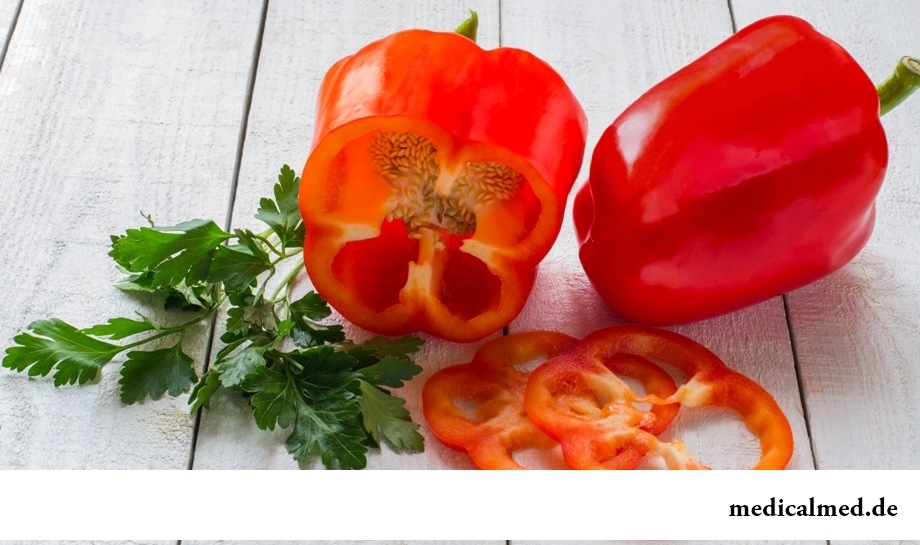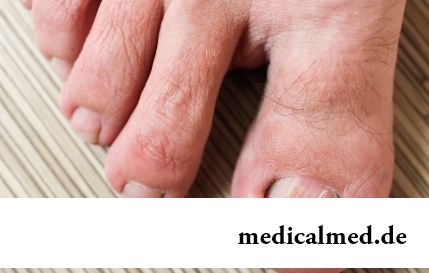





Vitamin C
Vitamin C belongs to water-soluble vitamins. Actually under such general name several forms of this substance – аскорбиген are integrated, isoascorbic acid, offended palmitate, a calcium ascorbate, etc.

The disease which was called a scurvy, and in transfer on Latin – "scurvy" developed in old times during the long travel at a lack of vitamin C of a diet at people. The name "ascorbic acid" comes from this word that in transfer means "protivotsingovy".
We will well dissolve vitamin C in water, spirit solutions, in alkaline and neutral environments it is inactivated, it is rather steady in subacidic environments. In general this very unstable substance which quickly collapses at the increased temperature, at contact with metals. The long soaking of products leads to transition of the most part of ascorbic acid to water, and 2-3 months of storage of fresh vegetables later and fruit a half of the vitamin which is contained in them collapses.
Content of vitamin is C in products
Most of all contains vitamin C in products of plant origin – fruit, berries, vegetables and herbs. In them it can contain in the oxidized, free and connected forms. In the connected state ascorbic acid is soaked up much worse, and in the oxidized form activity its same, as well as in free.
Content of vitamin is C in some products (mg / 100):
- Brussels sprout – 120;
- Pepper green sweet – 150;
- Tomatoes soil – 100;
- Orange – 60;
- Dogrose fresh – 470;
- Blackcurrant – 200;
- Horse-radish – 55;
- Cranberry – 15;
- Sea-buckthorn – 200;
- Spinach – 55;
- Parsley greens – 150;
- Cabbage fermented – 30;
- Wild strawberry garden – 60;
- White cabbage – 45;
- Apples Antonovka – 30;
- Lemon – 40;
- Tangerine – 38;
- Parsley a root – 35;
- Fresh chanterelle mushrooms – 34;
- Swede – 30;
- Cherry – 15;
- Gooseberry – 30;
- Radish – 29;
- Kefir fat – 0,7;
- Fresh green peas – 25;
- Raspberry – 25;
- Garden radish – 25;
- Quince – 23;
- Potatoes – 20;
- Haricot pods – 20;
- Cowberry – 15;
- Salad-15;
- Apricots – 10;
- Bananas – 10;
- Onion – 10;
- Water-melon – 7.
Heat treatment destroys to 90% of vitamin C in products. At long transportation of fruit and vegetables from the place of their growth the content of vitamin C in them also decreases. It does not occur if before transportation to subject products to bystry freezing. To keep in them as long as possible ascorbic acid, it is necessary to store them in the cool and dark place.
Norms of consumption of vitamin C
The need for ascorbic acid during the different periods of life differs, it is higher in living conditions on Far North at pregnancy and breastfeeding, at stresses and an exercise stress, in the presence of addictions.
Children of the first half of the year of life need 30 mg/days of ascorbic acid, from 6 to 12 months – 35 mg/days, aged from 1 up to 3 years – 40 mg/days, from 4 to 10 years – 45 mg/days.
Boys from 11 to 14 years need in 50 mg of ascorbic acid a day, men up to 50 years of 60 mg/days, 50 years – 70 mg/days are more senior.
Girls at the age of 11-14 years have enough 50 mg/days of ascorbic acid, to women up to 60 years of 60 mg/days, at pregnancy requirement increases to 100 mg/days, in the period of a lactation to 120 mg/days.
Role of ascorbic acid in an organism
It is difficult to revaluate a vitamin C role in an organism, he participates in many important processes of an organism:
- Takes part in formation of collagen – the main component of connecting fabric;
- Does walls of blood vessels by stronger;
- Raises a host defense;
- Reduces the content of cholesterol;
- Participates in adrenaline synthesis, in metabolism of folic acid;
- Carries out protection of an organism against free radicals of oxygen;
- Reduces harmful effects of excess of sugar;
- Improves an angenesis;
- Increases resistance to a stress;
- Stimulates transformation of bivalent iron in trivalent which is better acquired by an organism.
Signs of a lack of vitamin C
In case of a hypovitaminosis resistance of an organism to infectious diseases decreases, outward of skin and hair worsens – skin becomes excessively dry, flabby, there are wrinkles, punctulate hemorrhages in the field of hair follicles, hair easily drop out and become dim.
The lack of vitamin C can be distinguished on the following symptoms:
- The raised bleeding of gums, hemorrhages in hypodermic cellulose ("bruises");
- Joint pain and muscles;
- Apathy, irritability, bystry fatigue;
- Bad healing of wounds and cuts;
- Reduced pressure.
Hypovitaminosis contributes to obesity.
Signs of excess of vitamin C
The use in high doses of ascorbic acid causes its overdose that is shown in deterioration in neuromuscular transmission, and from here and increased fatigue. Coordination of movements and their coherence with the visual analyzer is broken. There are failures in work of a pancreas, a liver that provokes digestive disturbances. Excess of ascorbic acid acidifies urine and is capable to cause loss of urates and oxalates in draft.

Use of vitamin C with the medical purpose
Ascorbic acid is used in schemes of treatment of allergic diseases, SARS and catarrhal diseases, herpes, obesity, by depressions, the increased uneasiness, a syndrome of a hyperactivity, atherosclerosis, osteochondrosis, an osteoarthrosis, anemia, alcoholism and others.
It is known that the lack of vitamin C provokes development of cancer diseases. Vitamin is accepted for the purpose of increase in physical and emotional stability. Its doses are individual depending on age and a disease. For prevention adults accept 50-100 mg of ascorbic acid after food once a day. The medical dose averages 50-100 mg of 3-5 times a day. Drugs on the basis of ascorbic acid for intake and solutions for intravenous and intramuscular administration are created.
Contraindications to vitamin C
Additional reception of vitamin C in dosage forms at tendency to a thrombogenesis, thrombophlebitises, the increased coagulability of blood is not recommended, at a diabetes mellitus.
Work which to the person not to liking, is much more harmful to his mentality, than lack of work in general.

Statistically, pathologies of a thyroid gland in the world more than 500 million people have. Failures in work of this body conduct to is heavy...
Section: Articles about health
No, probably, the person who would not have cold. Cold, cough, a headache – these symptoms are known to everyone. The peak of catarrhal diseases is the share of fall. SARS already came to schools and kindergartens, flu slowly makes the way to the cities, in a word, з...
Section: Articles about health
Practically each person is familiar with the annoying, pulling, unscrewing pains caused by overcooling of muscles of a back. In certain cases inflammatory process is not limited to discomfort, being followed by emergence of hypostasis, consolidations, temperature increase. At the wrong treatment the acute miositis can lead to a chronic disease or aggravation of other pathologies of a back (vertebral hernia, osteochondrosis) therefore it is important to pay attention to symptoms of an illness in time and to start to...
Section: Articles about health
The popular expression "run from a heart attack" became the motto of the people supporting active lifestyle. Moreover, run became peculiar...
Section: Articles about health
For the person who daily since morning gathers for work it is very important to wake up vigorous and ready by day of work. Actually, each of us experiences difficulties with this, at first sight, simple business from time to time. On a condition of an organism after ночн...
Section: Articles about health
The drugs stopping or oppressing life activity of pathogenic microorganisms are widely applied in clinical practice from 40th years of the last century. Originally antibiotics were called only substances natural (animal, vegetable or microbic) origins, but over time this concept extended, and it includes also semi-synthetic and completely artificial antibacterial drugs....
Section: Articles about health
Dogrose – one of the most widespread adornment and medicinal plants growing practically in all territory ours...
Section: Articles about health
Cold, puffiness of a nose, itch, the watering eyes - characteristic symptoms of the allergic rhinitis resulting from hit of allergens (pollen, house dust, hair of animals, etc.) on a mucous membrane of a nose. Unpleasant feelings often deliver беспоко...
Section: Articles about health
About 20% of the population of our planet have a hypertension (permanent increase in arterial pressure). This disease has an adverse effect on the standard of living, reduces working capacity, and in the absence of systematic treatment threatens with such complications as a myocardial infarction, a stroke and other heavy illnesses which can result in disability or sudden death. Most of patients for maintenance of pressure at more or less acceptable level accept appointed doctors лекарст...
Section: Articles about health
The thought that the mass of their body is too big at least once in life visits from 80 to 95% of women. Many...
Section: Articles about health
You are office worker, the driver, the fan of winter sports or do not think of life without bicycle? You lead a slow-moving life and you move on the city only on the car? You have no constant partner and you do not love the protected sex? Attention! You one...
Section: Articles about health
The modern person not always manages to find housing in the environmentally friendly region and such work which would not do harm to health. With food stuffs at first sight the situation is much better: shops are overflowed with goods which are positioned by producers as very useful and absolutely safe. Many Russians are absolutely sure that the choice of products with marking "bio", "эко" or "organik" guarantees them and members of their families an optimal variant of food. To a sozhala...
Section: Articles about health
Wood louse – the ordinary-looking unpretentious plant extended in all territory of our country. It quickly expands, and sometimes for...
Section: Articles about health
Each person has easy indispositions which he transfers "standing", trying not to ask for medical care. Arguments at the same time are adduced same: "it is a trifle, itself will pass", "I have too many important issues", "there are no wish to spend time on...
Section: Articles about health
Nightmares belong to the most unpleasant frustration. Statistically, they happen at 4% of adults, and almost at 70% of children and teenagers. During a nightmare of people dreams himself in extremely difficult, life-threatening situation. He wakens suddenly, in a condition of a fright, and, as a rule, remembers the dream distinctly. The feeling of depression and alarm does not release throughout the day, creating hindrances for work and normal communication. If such episodes repeat often, can р...
Section: Articles about health
Cellulitis - very widespread cosmetic shortcoming which arises approximately at 80% of women sooner or later. Emergence ег...
Section: Articles about health
Deciding to get rid of an addiction, not all imagine what effects it is necessary to face. Process of refusal of smoking causes quite essential discomfort in most of people: differences of mood, sleep disorder, fatigue, decrease физич...
Section: Articles about health
The medicine promptly develops, and the fact that else quite recently it seemed by miracle can now. We are not surprised any more to the fact that people with artificial joints and extremities can play sports, organ transplantation became a routine, and the latest cancer medicine allowed to achieve reduction of mortality in tens of times. Miracles of plastic surgery thanks to which people in 60 years are in the flower of beauty and freshness, too not a sensation any more....
Section: Articles about health
Urogenital candidiasis (milkwoman) – a fungal infection which annoys unpleasant feelings in the field of generative organs, сопр...
Section: Articles about health
According to data of World Health Organization, the cataract is diagnosed almost for 7% of the population of Earth. The statistics of incidence is considered not full as at an initial stage the illness, as a rule, does not cause to the person of special inconveniences, and many having got sick...
Section: Articles about health
Frosty air, fresh wind and easy snowball at most of Russians are associated with cheerfulness, health and cheerful entertainments on which our winter is so generous. But, unfortunately, cold season sometimes brings also troubles with health. It is not about seasonal colds and frostbites, and about those chronic illnesses which symptoms are shown preferential in the winter....
Section: Articles about health
The kid who was recently born is surrounded with love of adult family members and their cares without which the baby cannot exist....
Section: Articles about health
Is told about advantage of domestic animals for development of the child much. But many parents nevertheless do not hurry to bring pets as are afraid that they can do harm to health of children. What troubles can really trap kids and how to make with...
Section: Articles about health
The nature does not stand stagnation and monotony. It is known that tissues of a human body atrophy if do not receive necessary loadings. It fully belongs also to a cerebral cortex: when it is not given full-time job, it begins to function worse. As a result memory decreases, the person becomes less bright, acquires information more slowly, hardly switches from one thought to another. There are problems at work, difficulties with communication and career development. These it is unpleasant...
Section: Articles about health
Among a set of the perfumery and cosmetic goods which are released today the special group is made by the means containing anti-bacterial...
Section: Articles about health
The word "onikhokriptoz" is unfamiliar to most of people, meanwhile quite so physicians call very widespread problem: the growing of edge of a nail into surrounding fabrics causing inflammatory process. Usually the illness affects thumbs of legs, and is followed покр...
Section: Articles about health
Life does not indulge the modern woman special emotional comfort and carelessness. The fatigue, troubles at work, misunderstanding in a family and various illnesses immediately affect a condition of hair and skin. And there is a wish to look safe and attractive so! Substantially competently picked up diet can improve situation....
Section: Articles about health
